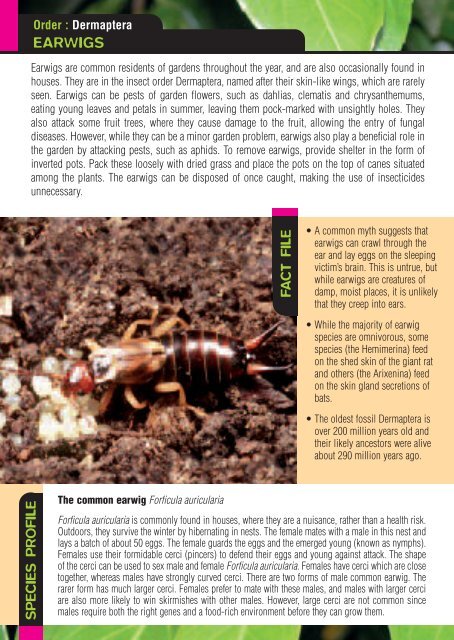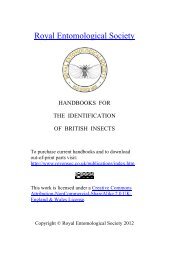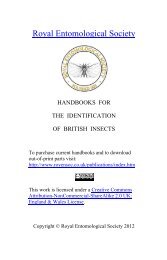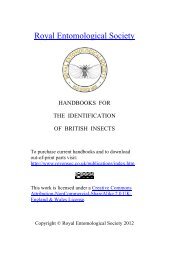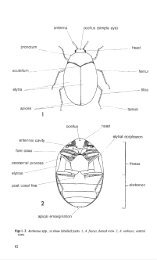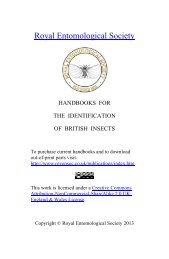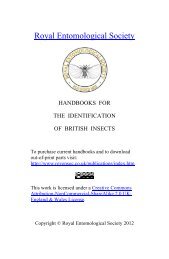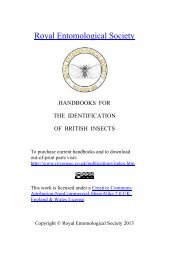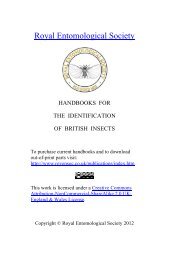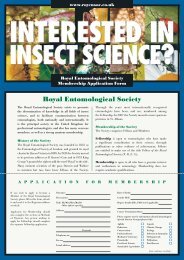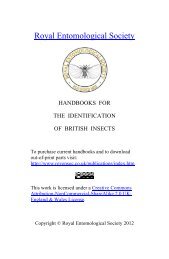Garden Entomology - Royal Entomological Society
Garden Entomology - Royal Entomological Society
Garden Entomology - Royal Entomological Society
Create successful ePaper yourself
Turn your PDF publications into a flip-book with our unique Google optimized e-Paper software.
Order : Dermaptera<br />
EARWIGS<br />
Earwigs are common residents of gardens throughout the year, and are also occasionally found in<br />
SPECIES PROFILE<br />
FACT FILE<br />
houses. They are in the insect order Dermaptera, named after their skin-like wings, which are rarely<br />
seen. Earwigs can be pests of garden flowers, such as dahlias, clematis and chrysanthemums,<br />
eating young leaves and petals in summer, leaving them pock-marked with unsightly holes. They<br />
also attack some fruit trees, where they cause damage to the fruit, allowing the entry of fungal<br />
diseases. However, while they can be a minor garden problem, earwigs also play a beneficial role in<br />
the garden by attacking pests, such as aphids. To remove earwigs, provide shelter in the form of<br />
inverted pots. Pack these loosely with dried grass and place the pots on the top of canes situated<br />
among the plants. The earwigs can be disposed of once caught, making the use of insecticides<br />
unnecessary.<br />
The common earwig Forficula auricularia<br />
• A common myth suggests that<br />
earwigs can crawl through the<br />
ear and lay eggs on the sleeping<br />
victim’s brain. This is untrue, but<br />
while earwigs are creatures of<br />
damp, moist places, it is unlikely<br />
that they creep into ears.<br />
• While the majority of earwig<br />
species are omnivorous, some<br />
species (the Hemimerina) feed<br />
on the shed skin of the giant rat<br />
and others (the Arixenina) feed<br />
on the skin gland secretions of<br />
bats.<br />
• The oldest fossil Dermaptera is<br />
over 200 million years old and<br />
their likely ancestors were alive<br />
about 290 million years ago.<br />
Forficula auricularia is commonly found in houses, where they are a nuisance, rather than a health risk.<br />
Outdoors, they survive the winter by hibernating in nests. The female mates with a male in this nest and<br />
lays a batch of about 50 eggs. The female guards the eggs and the emerged young (known as nymphs).<br />
Females use their formidable cerci (pincers) to defend their eggs and young against attack. The shape<br />
of the cerci can be used to sex male and female Forficula auricularia. Females have cerci which are close<br />
together, whereas males have strongly curved cerci. There are two forms of male common earwig. The<br />
rarer form has much larger cerci. Females prefer to mate with these males, and males with larger cerci<br />
are also more likely to win skirmishes with other males. However, large cerci are not common since<br />
males require both the right genes and a food-rich environment before they can grow them.


